Overview
This article aims to provide practical brainstorming examples designed to inspire creativity and idea generation, especially for those navigating the often challenging waters of career transitions. We understand that such changes can be daunting, and it’s crucial to explore various brainstorming techniques—like mind mapping and brainwriting—that not only encourage collaboration but also foster inclusivity. These methods can significantly enhance creativity and lead to innovative solutions, ultimately making a positive impact on both personal and professional growth.
As you reflect on your own journey, consider the emotional weight of these transitions. It’s normal to feel uncertain or overwhelmed. However, by embracing effective brainstorming strategies, you can transform these feelings into opportunities for growth. Imagine the sense of empowerment that comes from harnessing your creativity and collaborating with others who share your aspirations.
You are not alone in this process. Many individuals have successfully navigated similar transitions, finding clarity and renewed purpose through effective brainstorming. By engaging with these techniques, you can take meaningful steps toward owning your career path. Remember, every idea has the potential to spark change, and your journey is filled with possibilities waiting to be explored.
Let’s take a moment to acknowledge the challenges you may face:
- Feeling lost in your career direction
- Struggling to generate new ideas
- Seeking support from others
These are all valid concerns, and they highlight the importance of taking action. By implementing the brainstorming techniques discussed, you can cultivate a nurturing environment for your creativity to flourish. Together, we can navigate this journey, ensuring that you feel supported and empowered every step of the way.
Introduction
In a world where career transitions are increasingly common and the job market is ever-evolving, we understand how daunting these changes can feel. The art of brainstorming emerges as a vital tool for innovation and problem-solving, offering a nurturing space for creativity to flourish. This dynamic collaborative technique not only empowers individuals and teams to explore diverse perspectives but also paves the way for fresh ideas and solutions that can ease your journey.
As organizations and professionals alike navigate the complexities of today’s economic landscape, it becomes essential to grasp the nuances of effective brainstorming. You are not alone in facing these challenges; many share your concerns. From classic methods to modern approaches, harnessing collective intelligence can significantly impact your career trajectory and contribute to business success. Embracing brainstorming as an indispensable skill can lead you toward financial stability and personal agency, fostering a sense of ownership over your career path.
Understanding Brainstorming: A Creative Process
Brainstorming is a dynamic and collaborative technique designed to generate a wealth of ideas in a condensed timeframe. For many individuals navigating the challenges of employability in a declining job market, this method can feel like a lifeline. It encourages participants to think freely and creatively, allowing for the exploration of diverse perspectives. As we approach 2025, the significance of idea generation has become increasingly clear across various sectors, including business, education, and personal development. It serves as a catalyst for innovation and enhances problem-solving capabilities, which are essential in today’s world.
For those following ‘Your Career 2.0: A Survival Guide for The Battered Career Syndrome and Investor Syndrome,’ grasping the fundamentals of this creative process is crucial for leveraging its practical applications effectively. This creative process not only stimulates individual creativity but also fosters collaboration among team members, leading to richer and more varied outcomes. Organizations conducting organized idea generation sessions have reported significant enhancements in innovation metrics. This is vital for attaining financial independence and personal agency during job transitions.
Have you ever felt the weight of uncertainty in your career? Significantly, some retailers have seen an 8% rise in sales, illustrating how effective idea generation can directly influence business success and aid in income growth.
Moreover, the incorporation of AI ideation tools has proven to be transformative for companies looking to enhance innovation and increase creativity. These tools support groups, including those in job transition, in producing ideas more effectively. They ensure that the idea generation process remains focused and productive. For individuals changing professions, AI tools can assist in recognizing potential job paths and opportunities, making the ideation process more relevant to their specific needs. Ultimately, this enhances their financial stability.
Experts emphasize the vital role of ideation in creative processes. As Gleb Tsipursky, a prominent figure in the future-of-work consultancy, observes, effective idea generation can significantly enhance user experiences and drive business success. Techniques such as SCAMPER—where teams are guided through prompts to explore improvements—have proven effective in maintaining momentum and structure during idea generation sessions. This is particularly beneficial for individuals navigating career changes.
These methods can directly tackle the emotional challenges encountered during transitions, offering a structured approach to generate solutions.
Real-world brainstorming examples further illustrate the impact of collaborative brainstorming. One notable case study involved a group using the ‘Wishing’ method, where participants articulated their ideal solutions and brainstormed pathways to achieve these wishes. This method not only revealed potential challenges but also nurtured a creative atmosphere favorable for producing innovative concepts.
For those changing careers, this method can assist in clarifying ambitions and pinpointing actionable steps toward reaching professional objectives. This ultimately improves their sense of agency and control over their financial future.
In summary, generating concepts is not simply a tool for thought creation; it is an essential part of the creative process that enables individuals and organizations to navigate challenges and seize opportunities in a constantly changing environment. Remember, you are not alone in this journey; support and resources are available to help you take ownership of your career.
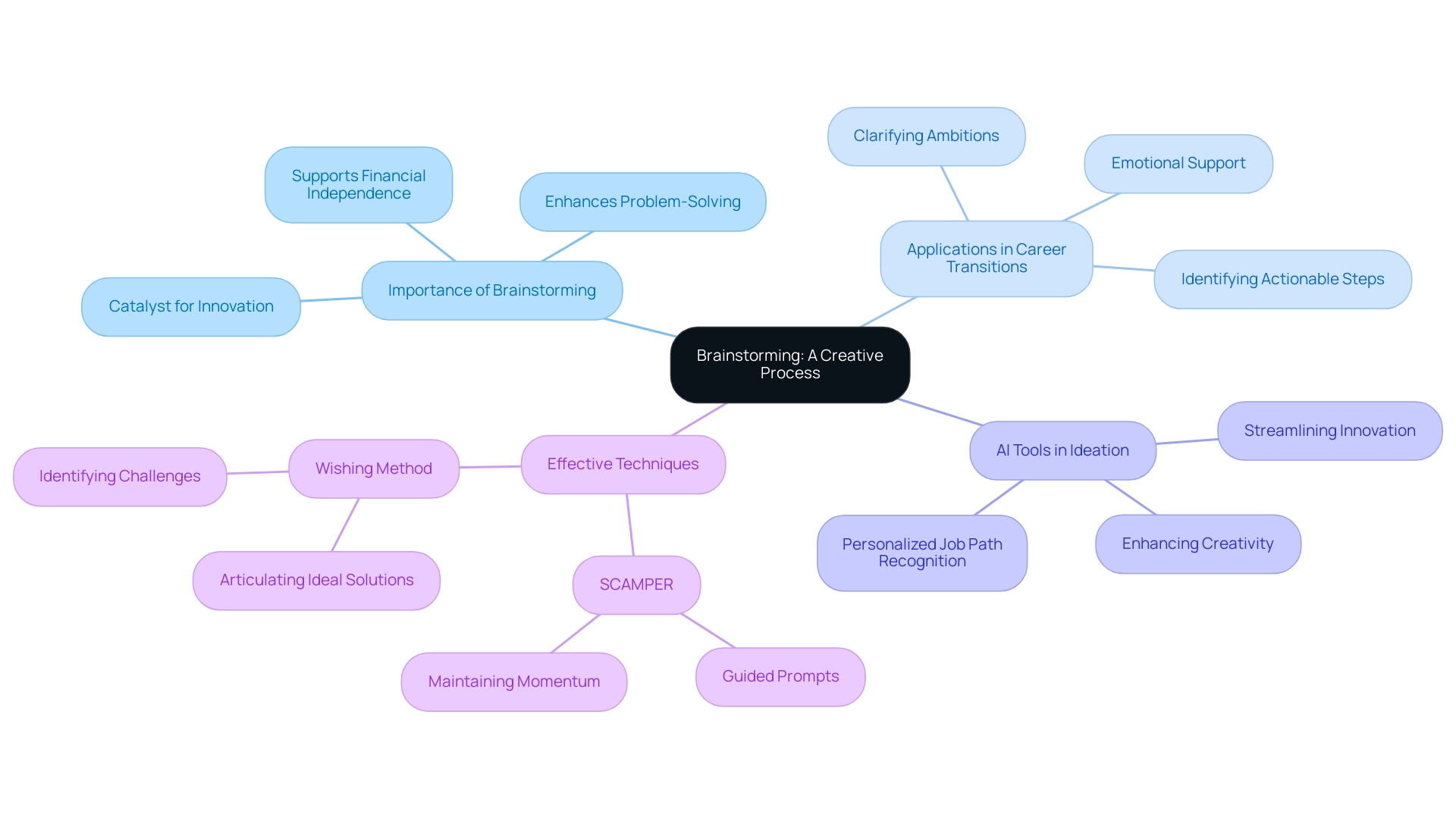
The Significance of Brainstorming in Idea Generation
Brainstorming examples play a crucial role in concept generation, allowing individuals and teams to break free from conventional thinking patterns. This creative process not only invites the exploration of new ideas and solutions but often leads to significant breakthroughs in both projects and personal endeavors. We understand that the collaborative aspect of idea generation can enhance team dynamics, fostering a sense of ownership and engagement among participants.
Indeed, have you ever felt that group thinking can enhance cognitive flexibility? Research suggests it can, enabling teams to produce a broader range of concepts and viewpoints. Notably, a study assessing cognitive flexibility in idea generation found no significant difference in cognitive flexibility for technique, with results showing F(31) = 0.06, p = 0.953, η = 0.01.
The importance of idea generation is highlighted by brainstorming examples of its effectiveness in creative industries, where successful sessions have led to innovative products and services. Companies that emphasize brainstorming in their idea generation often report higher levels of creativity and collaboration, essential for maintaining a competitive edge. In 2025, statistics indicate that teams participating in organized thought sessions experience a 30% rise in originality of concepts compared to those who do not.
Moreover, expert opinions emphasize that brainstorming not only improves the quality of concepts but also strengthens team cohesion. Research indicates that generating concepts individually prior to collaborating in a group environment significantly enhances the originality and quality of the concepts produced. As Simone M. Ritter, a researcher, notes, “These findings suggest that producing concepts in a group after producing concepts individually has a strong beneficial effect on the originality, and thus the quality of the concepts generated.”
This approach enables team members to offer unique viewpoints, enhancing the overall idea generation experience.
Case studies further demonstrate the importance of collective thinking in generating brainstorming examples. For instance, a leading tech company conducted regular idea generation sessions that resulted in the development of a groundbreaking app, showcasing how effective creativity can lead to tangible success. Furthermore, The Entrepreneur’s Source highlights a thorough and customized method to professional coaching, providing free services and an organized process that can empower you to utilize the power of idea generation in your vocational journey.
As organizations continue to navigate the complexities of the modern business landscape, we recognize that the role of idea generation in fostering innovation and enhancing team dynamics remains more critical than ever. Remember, you are not alone in this journey; together, we can unlock the potential that lies within your ideas.
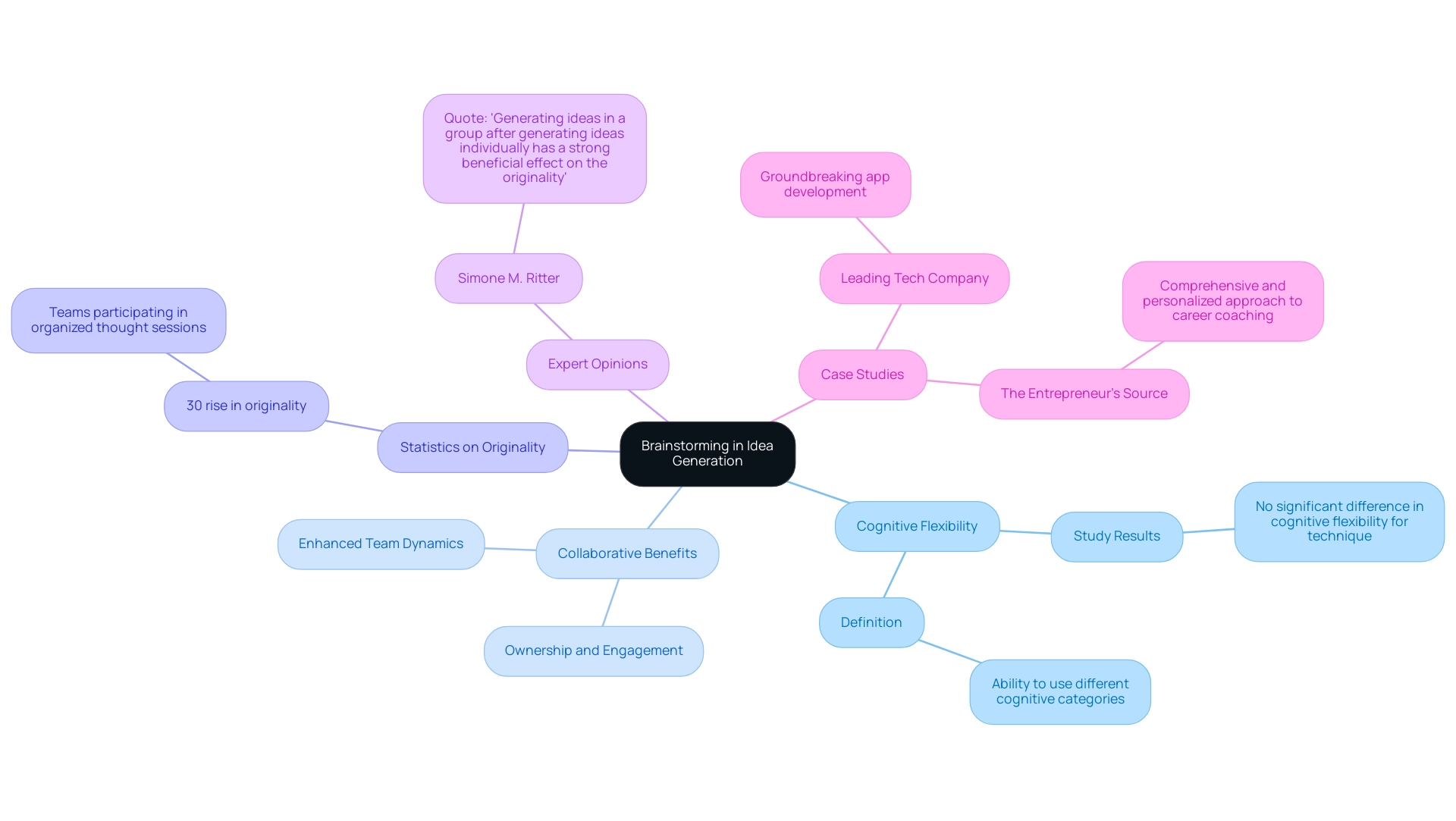
Classic Brainstorming Techniques to Get Started
Traditional ideation methods are invaluable resources for entrepreneurs, especially those navigating the complexities of career changes. If you’re feeling overwhelmed, know that you’re not alone. Methods like freewriting, mind mapping, and round-robin brainstorming can significantly foster creativity and collaboration, particularly as outlined in ‘Your Career 2.0: A Survival Guide for The Battered Career Syndrome and Investor Syndrome.’
Freewriting allows individuals to write continuously for a set time, liberating thoughts from the constraints of grammar and structure. This technique encourages the free flow of ideas, enabling you to explore your thoughts without the fear of judgment. Research suggests that freewriting can enhance concept generation, with success rates in 2025 indicating a notable increase in creative outputs when this method is employed. For those experiencing career transitions, freewriting can be a powerful tool to articulate and refine business ideas that align with your personal aspirations and market demands. It can help individuals with Battered Career Syndrome express their frustrations and ambitions, leading to clearer business concepts.
Mind mapping serves as a visual tool that organizes thoughts around a central idea. By creating a diagram that connects related concepts, mind mapping helps both individuals and teams recognize the relationships among their thoughts. This technique not only clarifies complex ideas but also improves memory retention, making it an effective method for generating new ideas. If you’re rethinking your career path, mind mapping can illuminate how your transferable skills can be applied in new business ventures, especially if you’re grappling with the uncertainties of Investor Syndrome.
Round-robin discussion is another structured method that ensures every participant contributes a suggestion in turn. This approach fosters inclusivity and guarantees that all voices are heard, resulting in a richer array of ideas. In 2025, statistics revealed that round-robin sessions led to higher engagement and more diverse concepts compared to traditional brainstorming methods. This method is particularly beneficial for those in career transitions, as it encourages networking and collaboration, helping to alleviate the feelings of isolation that often accompany such changes.
These classic approaches exemplify effective brainstorming techniques that can be tailored to various contexts, making them versatile tools for entrepreneurs. For instance, a case study on SWOT analysis in user-centered design demonstrates how teams can utilize idea generation within the framework of strengths, weaknesses, opportunities, and threats. This organized method not only clarifies project workflows but also aids teams in crafting strategies that leverage their strengths while addressing potential challenges.
Incorporating these practices into your creative sessions can lead to more productive concept generation and problem-solving. By understanding and applying freewriting, mind mapping, and round-robin brainstorming, you can unlock your creative potential and propel your business ideas forward. As Parnell Woodard, a Career Ownership Coach, emphasizes, organized idea-generation methods are crucial for those navigating job changes, providing clarity and direction in your professional journey.
Additionally, The Entrepreneur’s Source offers free coaching services that can assist you in effectively applying these creative techniques during job transitions, ensuring you are well-prepared to explore new opportunities. To further enrich your journey, consider engaging with ‘Your Career 2.0: A Survival Guide for The Battered Career Syndrome and Investor Syndrome’ as a valuable resource for navigating your path to business ownership.
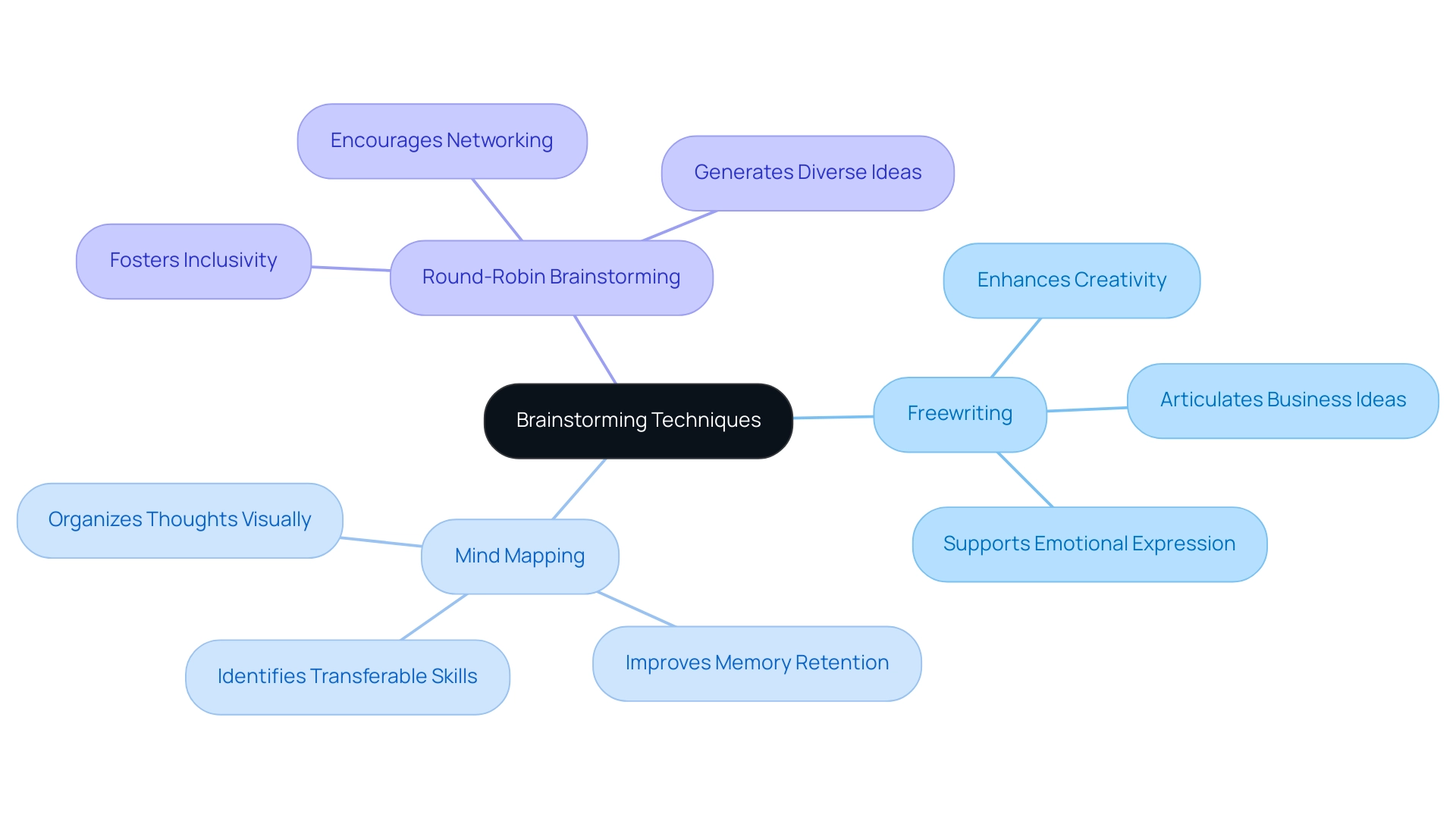
Exploring Modern Brainstorming Methods for Enhanced Creativity
Contemporary brainstorming examples have evolved to include innovative strategies such as brainwriting, starbursting, and reverse brainstorming, each designed to enhance creativity and collaboration. These methods resonate deeply with individuals navigating job transitions, as they empower participants to explore new possibilities and tackle challenges head-on. Many career transitioners express the emotional and practical effects of income increases—especially when moving from corporate roles to entrepreneurship or investing in franchises. These techniques provide a nurturing framework for generating ideas that can lead to financial stability and a sense of career ownership.
- Brainwriting allows participants to jot down their thoughts independently before sharing them with the group. This approach alleviates the pressure of immediate verbal contributions, creating a more inclusive environment where every voice can be heard. Research shows that this method can significantly boost both the quantity and quality of ideas generated, as individuals feel more at ease expressing their thoughts without fear of judgment.
The Entrepreneur’s Source has assisted hundreds of thousands in evaluating their professional options, highlighting the effectiveness of such inclusive methods in fostering personal development, particularly in enhancing income potential during transitions. For instance, case studies from ‘Your Career Revolution’ reveal how individuals have successfully employed these methods to increase their income, leading to reduced stress in managing financial responsibilities.
-
Starbursting shifts the emphasis from generating answers to crafting questions. By encouraging participants to inquire who, what, where, when, and why about a topic, this method fosters deeper exploration and critical thinking regarding professional pathways. It helps teams uncover aspects of a project that might have been overlooked, resulting in more comprehensive solutions. Understanding these challenges can empower individuals and teams to unleash their creative potential, aligning with the mission of The Entrepreneur’s Source. The urgency to act on these insights is crucial, as timely decisions can profoundly influence income growth and career satisfaction.
-
Reverse ideation adopts a unique perspective by identifying potential problems or obstacles rather than solutions. This method can unveil hidden challenges and inspire innovative solutions by prompting participants to critically consider what might go wrong. For example, a case study named ‘Wishing’ illustrates how articulating desires for solutions can generate ideas to achieve them while also acknowledging possible challenges. This approach encourages creative thinking and helps identify obstacles that may need addressing in the pursuit of solutions, underscoring the urgency to advance in one’s career.
These contemporary idea generation methods, including brainstorming examples, not only nurture creativity but also empower individuals and teams to unlock their full potential. In 2025, statistics indicate that organizations employing these approaches report a 30% increase in innovative results compared to traditional idea generation methods. By effectively utilizing brainwriting, starbursting, and reverse ideation, teams can navigate the complexities of problem-solving and propel their projects forward with renewed energy, ultimately leading to professional advancements that meet the pressing need for income growth.
Insights from creativity specialists underscore the importance of these methods in cultivating an environment conducive to innovation. As Tiffany Lewis, a writer with a background in Business Management, observes, mastering these brainstorming techniques will be essential for those looking to reinvent their professional lives and achieve ownership of their work. This connection to The Entrepreneur’s Source’s mission highlights how these methods can specifically support individuals on their journey toward career ownership.
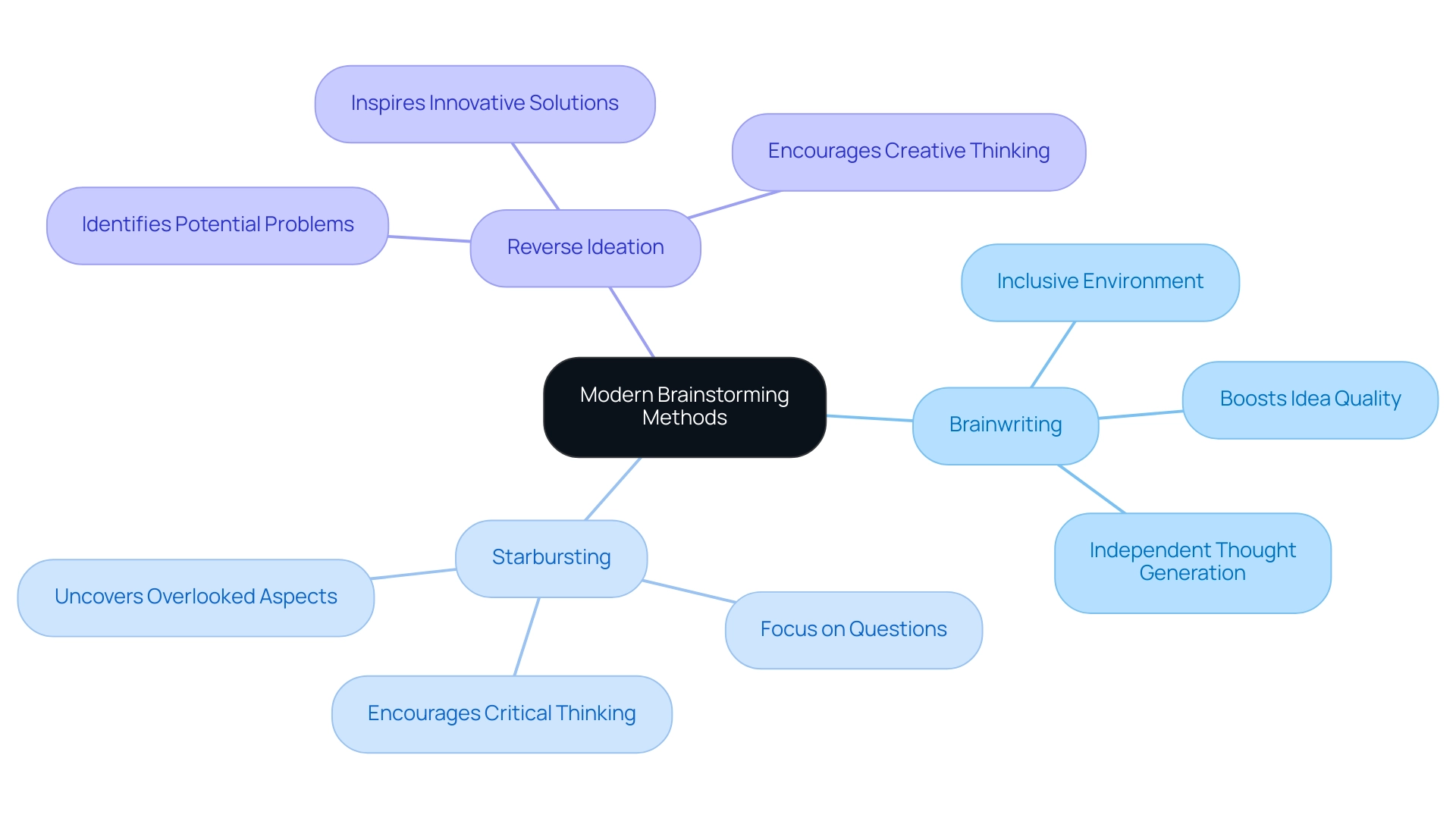
10 Practical Brainstorming Examples to Ignite Your Ideas
- Mind Mapping: Imagine a way to visually organize your thoughts around a central theme. Mind mapping does just that, simplifying complex issues and enhancing your understanding. A survey by Chuck Frey revealed that 67% of respondents found this method beneficial for strategic planning and knowledge management. By distilling information effectively, as shown in the case study “Simplifying Complex Issues with Mind Mapping,” you can navigate project management more easily. This technique not only aids in project management but also empowers you during career transitions by clarifying your goals and linking transferable skills to new opportunities—essential for overcoming the limitations of conventional career paths.
- Brainwriting: Have you ever felt that your ideas get lost in the noise of group discussions? Brainwriting allows participants to silently jot down their thoughts before sharing, ensuring that every voice is heard. This approach fosters individual creativity and inclusivity, which is particularly valuable for those changing careers. It opens up a world of varied viewpoints on potential business concepts, reinforcing the importance of financial independence.
- SCAMPER: Are you ready to innovate? SCAMPER—Substitute, Combine, Adapt, Modify, Put to another use, Eliminate, and Reverse—provides prompts to modify existing ideas and generate new solutions. This method has proven successful in brainstorming sessions, making it a valuable tool for entrepreneurs looking to enhance their creative processes. By applying SCAMPER to your past experiences, you can leverage transferable skills for new ventures, helping to mitigate risks and accelerate your career transition.
- Role Storming: What if stepping into someone else’s shoes could spark new ideas? Role storming encourages participants to adopt different perspectives, leading to unique insights that traditional brainstorming might miss. For those navigating career changes, this technique can unveil new pathways and entrepreneurial opportunities, especially in a challenging job market.
- Rapid Ideation: Feeling stuck? Set a timer and challenge yourself to generate as many ideas as possible in a short timeframe. This fast-paced approach can stimulate creativity and help you overcome mental blocks, resulting in a wealth of ideas in just minutes. For those transitioning careers, rapid ideation can quickly uncover innovative solutions and potential business directions, empowering you to take control of your future.
- Question Brainstorming: Are you asking the right questions? This technique shifts the focus from answers to generating questions about a specific topic. By doing so, you can uncover new perspectives and delve deeper into your concepts. For career transitioners, asking the right questions can reveal valuable insights about your next steps, especially in today’s evolving job landscape.
- Visual Brainstorming: How do you express your ideas? Visual brainstorming invites participants to use drawings or images, tapping into visual thinking to enhance creativity and make abstract concepts tangible. This method can articulate the vision and goals of new business ventures, which is crucial for building a sustainable future.
- Group Sketching: Have you tried sketching your concepts together? Collaboratively sketching on a whiteboard allows teams to visualize their thoughts, leading to richer discussions and refined ideas. This interactive method is particularly beneficial for those solidifying their entrepreneurial visions.
- Storyboarding: Can you see the flow of your ideas? Storyboarding helps create a visual narrative to explore the interconnections between concepts. This technique is especially useful in project planning, as it clarifies the pathway from your current profession to new ventures, highlighting the importance of financial planning.
- Online Collaboration: Are you leveraging digital tools for connection? In today’s digital world, online collaboration enables remote discussions, allowing participants to share ideas from anywhere. This method is increasingly relevant for job transitioners seeking opportunities beyond traditional employment, linking them with a supportive community of like-minded individuals.
These brainstorming methods can adapt to various contexts, from business meetings to personal projects, empowering you to ignite your creativity and explore innovative business ideas. Moreover, The Entrepreneur’s Source offers complimentary consultations to assist you in your job transitions, making these methods even more relevant for those eager to take charge of their professional futures.
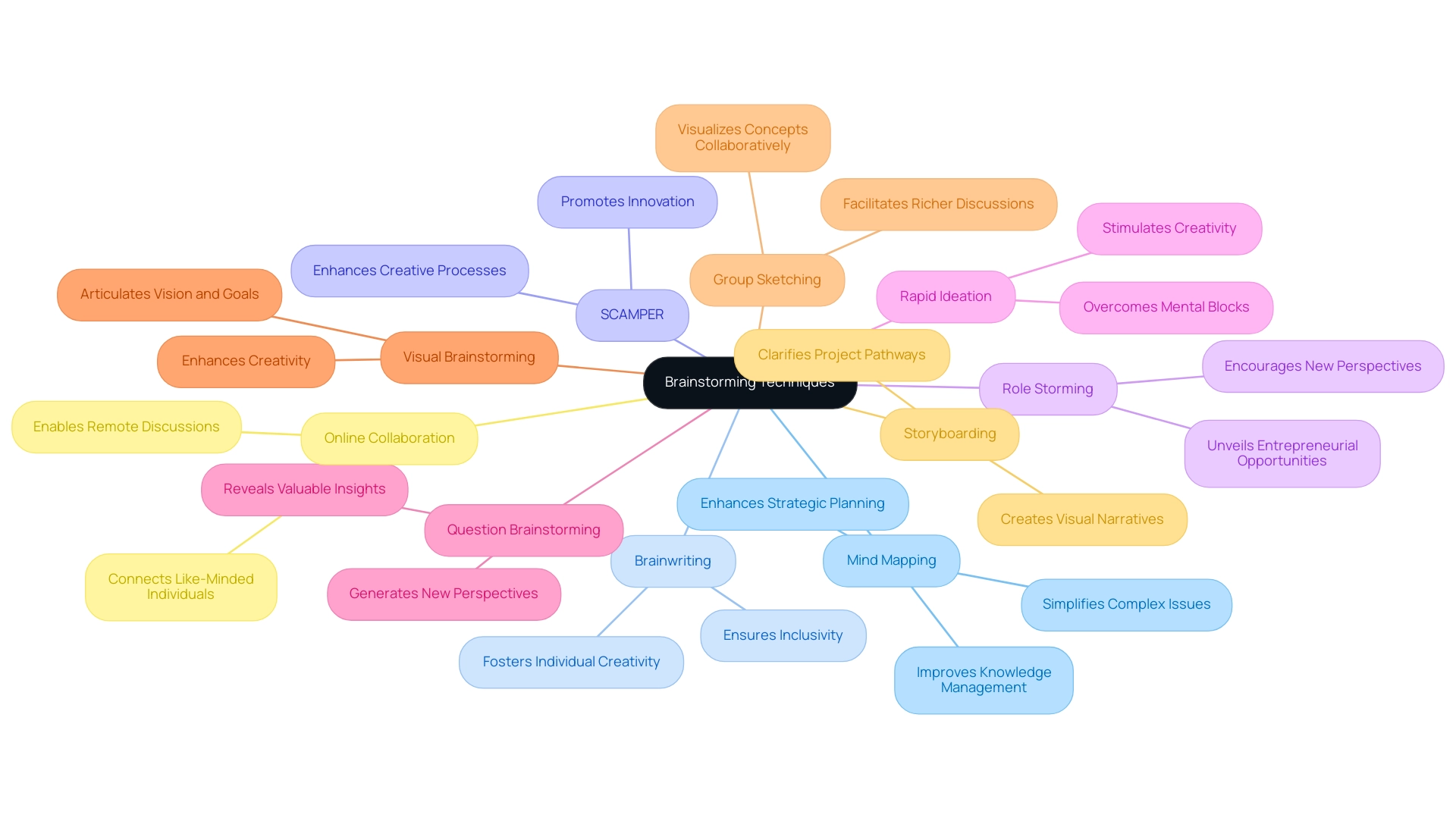
Applying Brainstorming Techniques in Real-Life Situations
Brainstorming examples can be effectively employed in numerous real-life scenarios, boosting creativity and problem-solving abilities, especially for individuals transitioning between jobs in a challenging market. Have you ever felt overwhelmed by the process of finding a new career path? You’re not alone. Here are some key applications that can help guide you through this journey:
- Product Development: Brainstorming serves as a powerful tool for generating innovative concepts for new products or features. By fostering an inclusive environment, teams can leverage diverse perspectives to create solutions that resonate with target audiences. This collaborative concept generation is essential for those aiming to take charge of their career trajectories. In Your Career 2.0: A Survival Guide for The Battered Career Syndrome and Investor Syndrome, individuals are aided in evaluating their career opportunities amid the constraints of traditional employment options.
- Marketing Campaigns: Have you considered how brainstorming can lead to distinctive strategies for promoting products or services? Companies that embrace collaborative idea generation often see higher engagement rates in their campaigns, tapping into the collective creativity of their teams. This approach is vital for those seeking financial independence through business ownership in a declining job market.
- Team Building: Utilizing collective thinking as a team-building exercise can significantly strengthen collaboration and improve team dynamics. Research indicates that 41% of workers have found that navigating conflicts during idea generation sessions has led to a better understanding of their colleagues, ultimately enhancing workplace relationships. This aligns with the transformative method promoted in Your Career Revolution, which demonstrates how effective communication can empower individuals in their professions and assist them in navigating age-related limitations.
- Problem Solving: When confronted with particular organizational challenges, brainstorming can help identify effective solutions. This approach promotes open dialogue and critical thinking, enabling teams to examine different perspectives and reach comprehensive conclusions. Encouraging analytical thought and varied team formation can assist in combating cognitive biases during evaluation, further improving the efficiency of creative sessions. This is crucial for those aiming to reduce risks and expedite their new professions in an unpredictable economic environment.
- Personal Growth: Have you taken the time to explore new professional paths or personal objectives? Individuals can utilize creative methods to investigate their aspirations and identify actionable steps toward achieving them. This reflective process fosters personal agency and empowerment as they seek to overcome the challenges of employability and financial stability.
By integrating these idea generation techniques into everyday practices, career transitioners can unlock their creative potential. This journey can drive meaningful outcomes in both product development and marketing initiatives, ultimately helping you work towards achieving your desired income, lifestyle, and financial freedom. Remember, you have the power to shape your future.
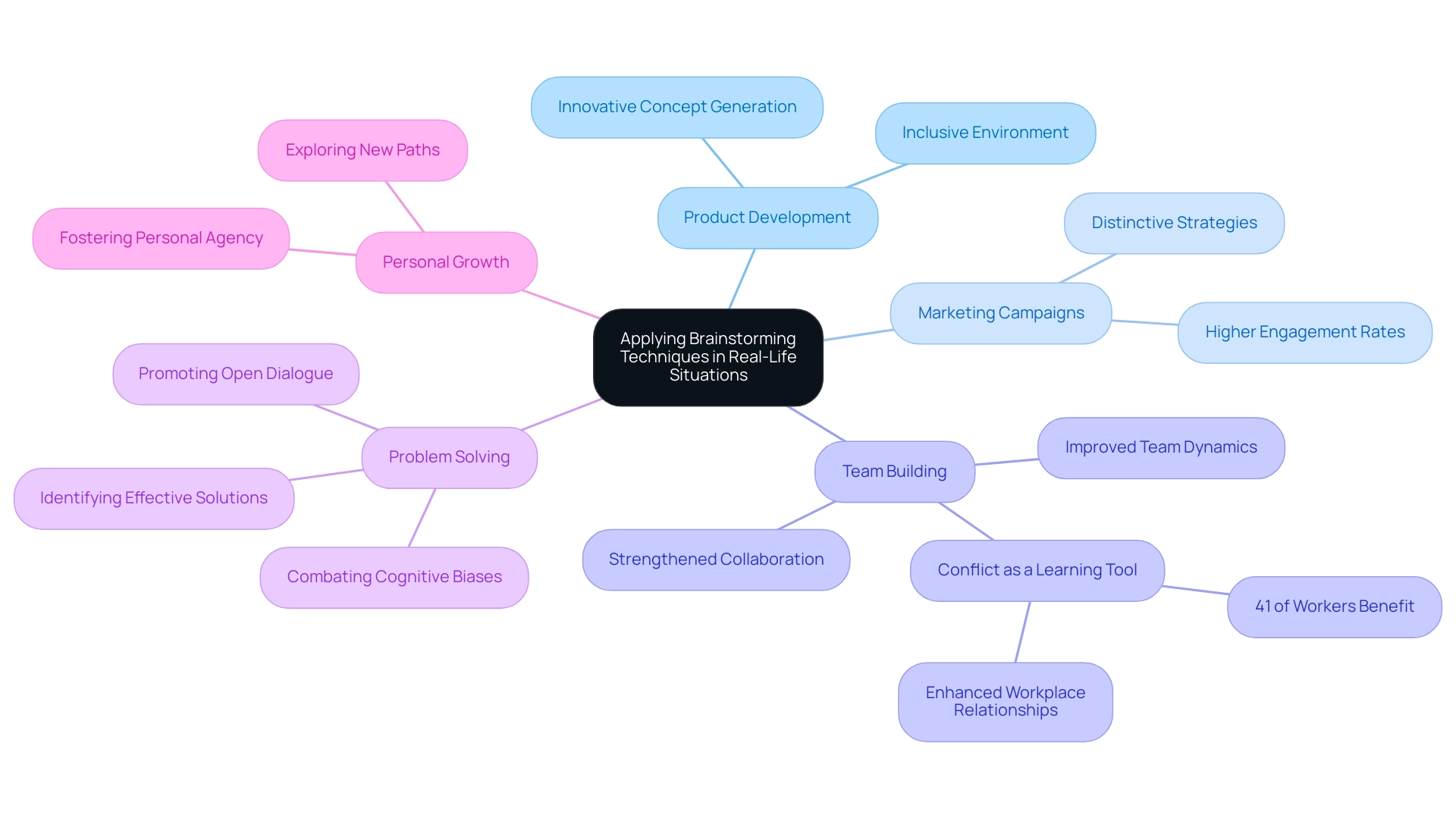
The Power of Collaborative Brainstorming
Collaborative thinking taps into the shared knowledge of a group, leading to a rich array of diverse and innovative concepts. By bringing together individuals from various backgrounds and perspectives, teams can explore a wider range of possibilities—an essential factor in today’s ever-changing business landscape. This approach not only nurtures creativity but also fosters a sense of community and shared purpose, significantly enhancing team cohesion and engagement.
Have you ever felt the power of collaboration? Research shows that organizations embracing collaborative thinking experience notable improvements in idea generation outcomes. In 2025, statistics suggest that groups employing effective idea generation methods can boost productivity by as much as 30%. This success largely stems from the open dialogue and psychological safety cultivated by inclusive leaders, who encourage contributions from every team member.
At The Entrepreneur’s Source, we understand the importance of collaborative efforts in professional development, having assisted hundreds of thousands in exploring their career possibilities.
Effective group idea generation sessions often employ various techniques, such as structured workshops and online collaboration tools. Companies that have adopted these methods report higher employee satisfaction and a more efficient work environment. Consider a tech firm that, through diverse team discussions, developed a groundbreaking product, increasing their market share by 15% within just a year.
Moreover, teamwork statistics reveal that good communication and the right tools significantly enhance productivity and employee satisfaction, reinforcing the effectiveness of collaborative idea generation.
The true power of collaborative idea generation lies in its ability to harness diverse perspectives, leading to more comprehensive solutions. Experts highlight that when teams embrace diversity in their sessions, they not only enhance creativity but also improve decision-making processes. As Jeremy Pollack, Principal at Pollack Peacebuilding Systems, wisely notes, “If you need assistance with conflict resolution in the workplace, you could always give us at Pollack Peacebuilding a call.”
This insight underscores the vital role of collaboration and communication in idea generation sessions. Looking ahead to 2025, nearly one-third of employees anticipate communication challenges, prompting 75% to explore new tools to achieve their business goals.
In summary, effective group creative thinking methods can greatly enhance the quality of concepts generated, especially when utilizing brainstorming techniques in a diverse setting. By nurturing an inclusive atmosphere where every voice is valued, organizations can unlock their teams’ full potential, driving innovation and success. Remember, you are not alone in this journey—together, we can achieve great things.
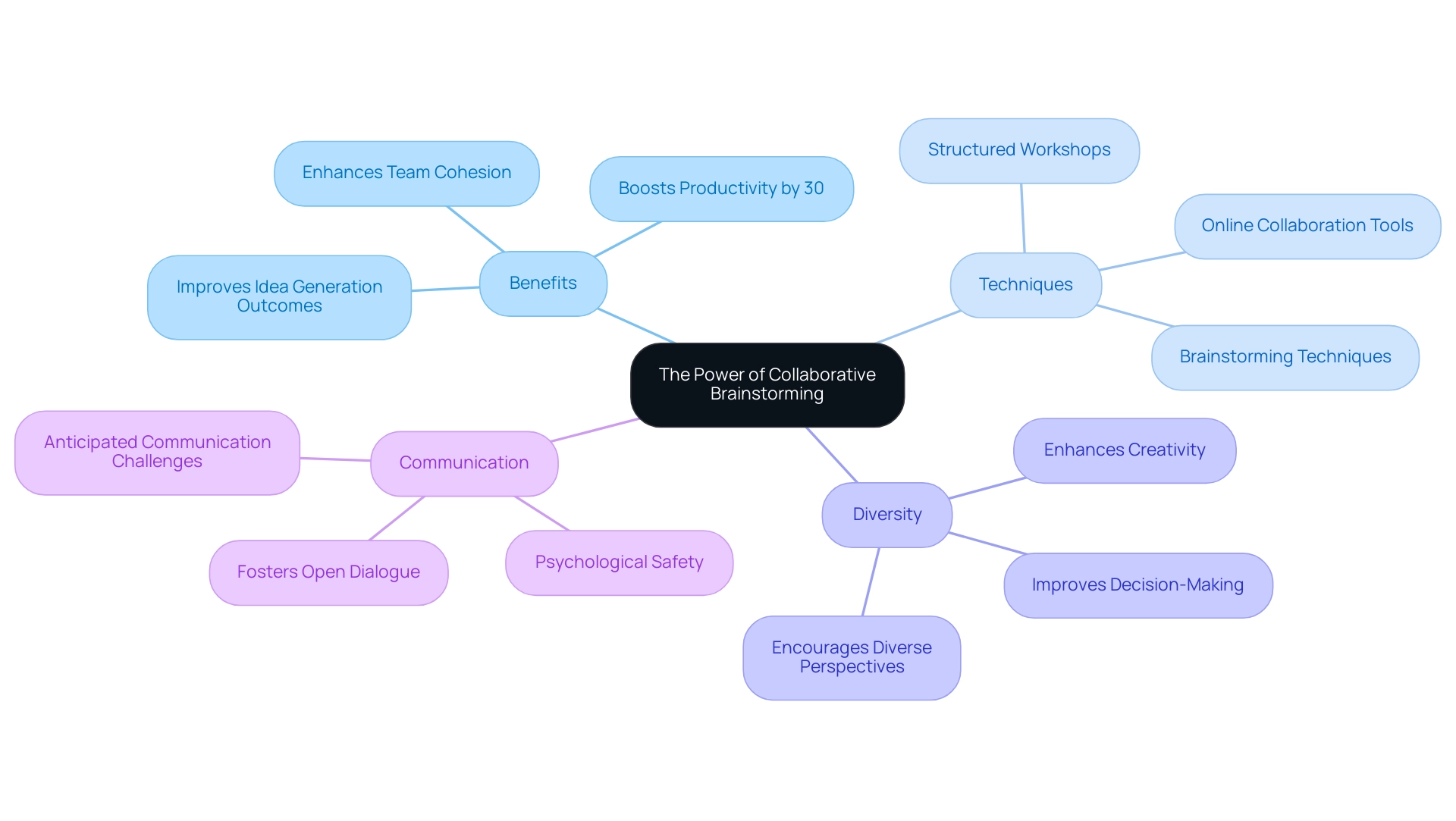
Overcoming Challenges in Brainstorming Sessions
Brainstorming examples often reveal several common challenges that can hinder creativity and collaboration, especially for those navigating a changing job market marked by a declining career economy and limited conventional career options. Addressing these issues is crucial for fostering an effective and inclusive environment. Here are some key challenges and strategies to overcome them:
- Groupthink: This phenomenon occurs when a desire for harmony or conformity results in a lack of diverse perspectives.
To combat groupthink, it is essential to actively encourage varied viewpoints. Have you ever noticed how conflicts can sometimes lead to improved working relationships? Research indicates that 33% of employees have experienced this, highlighting the value of constructive disagreement in creative processes. As Linda noted, focusing too much on the problem itself can hinder progress, and moderators should strive to prevent this.
- Dominating Participants: In many sessions, certain individuals may overshadow others, stifling contributions from quieter team members.
Establishing ground rules that promote equal participation can help mitigate this issue. Techniques such as round-robin sharing or anonymous suggestions can ensure that everyone has an opportunity to voice their thoughts. This is essential for those with transferable skills seeking to contribute meaningfully.
- Lack of Focus: Without a clear direction, brainstorming can devolve into unfocused discussions.
Clearly defining the topic and objectives at the outset is vital. This clarity not only keeps the session on track but also enhances the likelihood of generating actionable concepts that align with personal agency and aspirations for financial freedom.
- Fear of Judgment: Participants may hesitate to share their thoughts due to concerns about criticism.
Creating a safe and supportive environment where all ideas are welcomed is essential. How would it feel to know that all contributions are valuable? This can be achieved by emphasizing that all contributions are valued, and by reframing feedback as constructive rather than critical, which is especially important for individuals re-energizing their careers.
In 2025, statistics reveal that 21% of employees observed higher performance in their teams following conflicts, underscoring the importance of addressing these challenges head-on. By implementing these strategies, facilitators can significantly enhance the effectiveness of brainstorming examples, leading to more innovative outcomes and a more engaged team. Additionally, the case study titled ‘Remote Work and Inclusion’ illustrates how inclusive practices in remote work environments can foster collaboration and creativity, which is particularly relevant for individuals undergoing transitions. By leveraging the comprehensive and personalized approach of The Entrepreneur’s Source, individuals can effectively address these challenges and unlock their professional potential, ultimately paving the path towards greater employability and financial freedom in a rapidly changing job market.
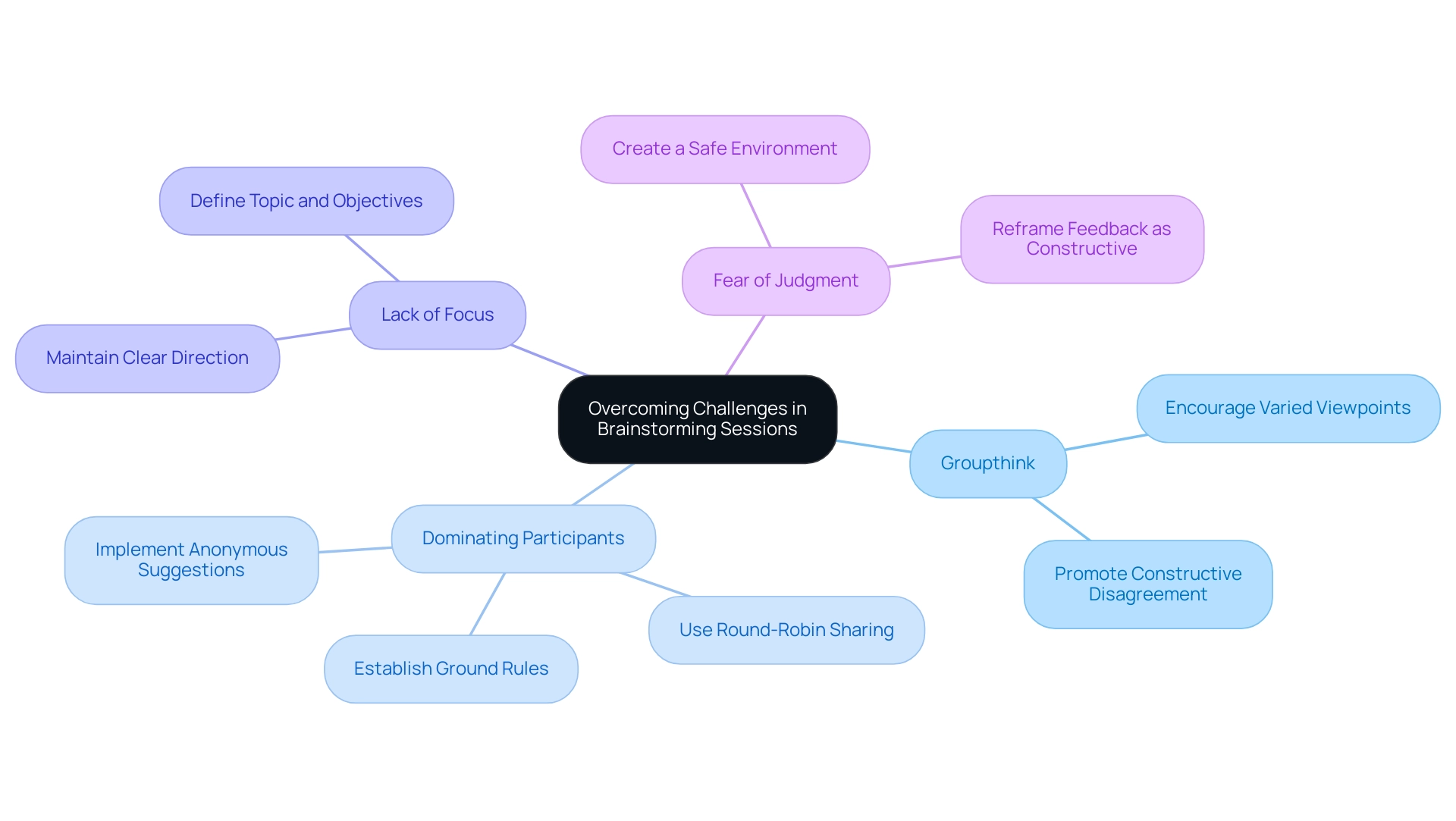
Refining Ideas: From Brainstorming to Actionable Plans
Refining brainstorming examples generated during brainstorming sessions is essential for transforming creativity into actionable plans, especially for those navigating the challenges of a declining job market and seeking financial freedom through business ownership. We understand that this journey can feel overwhelming. That’s why ‘Your Career 2.0: A Survival Guide for The Battered Career Syndrome and Investor Syndrome’ is an invaluable resource to guide you. Here are some essential steps to help you through this process:
- Categorize Concepts: Begin by grouping similar thoughts to uncover common themes. This step is vital in identifying concepts that resonate most with your entrepreneurial objectives.
- Evaluate Feasibility: Consider the practicality of each concept by assessing available resources, potential constraints, and alignment with your overall goals. This evaluation ensures that only viable concepts, including brainstorming examples, progress on your path to career ownership.
- Prioritize Concepts: Rank the concepts based on criteria such as potential impact and required effort. This prioritization enables you to focus on the most promising ideas that can drive significant results and foster your personal agency.
- Develop Action Plans: For the top-ranked concepts, outline specific steps for implementation. Assign responsibilities, set timelines, and determine necessary resources to create a clear path forward.
By following these structured steps, you can effectively transform brainstorming examples into actionable plans. The methodologies discussed in ‘Your Career 2.0’ emphasize the importance of asking better questions. Hal Gregersen from MIT highlights that reframing problems through inquiry can lead to innovative solutions. His case study, ‘Better Brainstorming Methodology,’ illustrates that by concentrating on generating questions instead of answers, teams can challenge assumptions and uncover new perspectives, leading to unexpected solutions and enhanced creativity.
In 2025, organizations that categorize and prioritize creative concepts reported success rates significantly higher than those that do not. This showcases the effectiveness of this approach in navigating career transitions. Furthermore, Gleb Tsipursky, CEO of Disaster Avoidance Experts, states, ‘The explosion of generative artificial intelligence (GenAI) has revolutionized the innovation process, suggesting ideas, offering data-driven insights, and playing devil’s advocate.’ This perspective highlights the evolving nature of idea generation methods and their relevance to emerging entrepreneurs.
Real-life examples demonstrate that organizations employing these strategies have effectively managed complex challenges, resulting in increased creativity and productivity. The Entrepreneur’s Source is dedicated to assisting individuals in utilizing these creative strategies, as described in ‘Your Career 2.0,’ to reach their professional goals and successfully transition to business ownership. Remember, you are not alone in this journey; support is available to help you thrive.
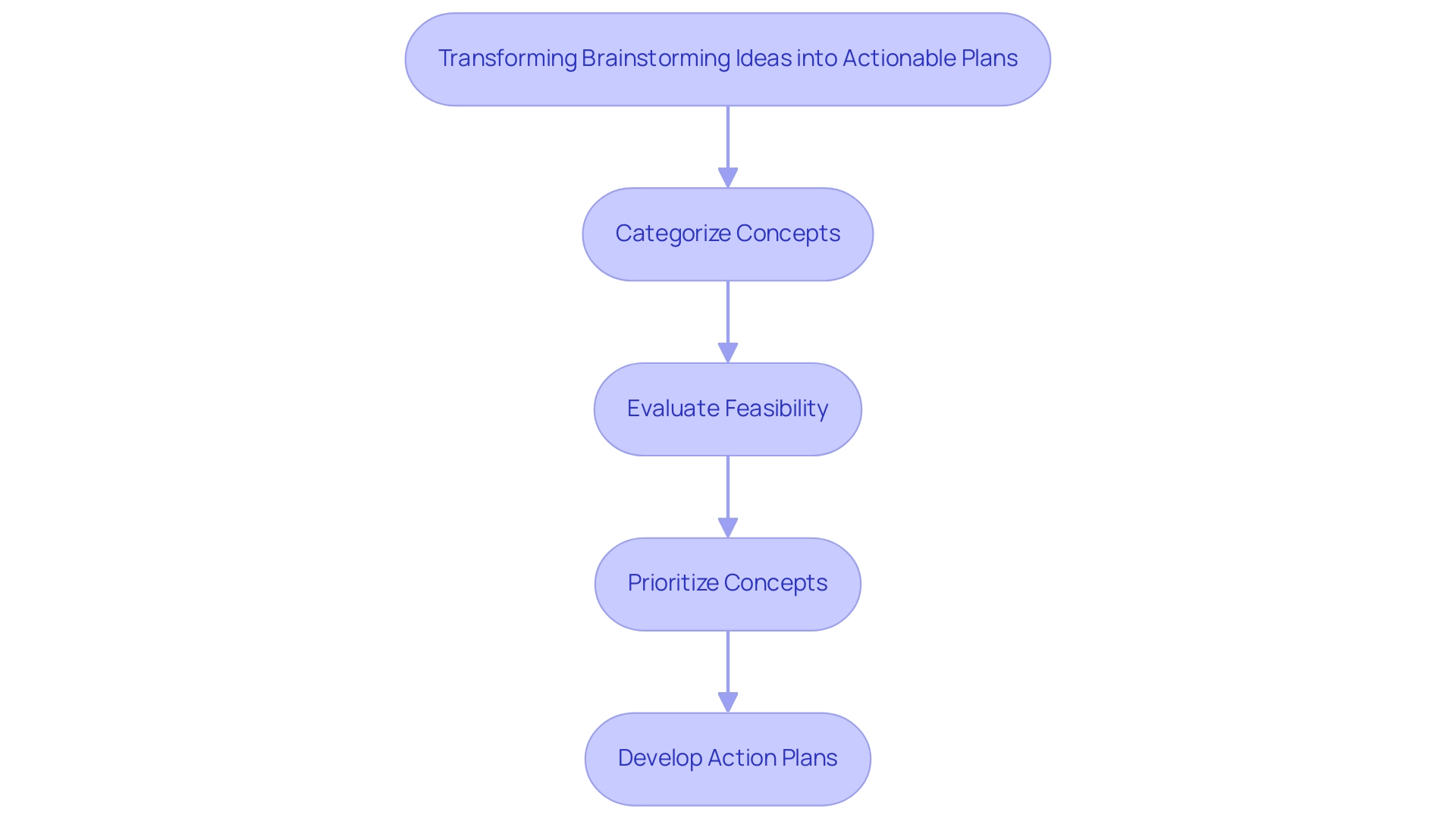
Putting Brainstorming Techniques into Practice
To successfully apply idea generation methods, it’s essential to choose an approach that aligns with your specific objectives and situation. Have you ever felt stuck in your creativity? Regularly scheduled brainstorming sessions, whether conducted individually or collaboratively, can nurture a culture of creativity that supports you. It’s beneficial to explore various techniques and adapt them to your unique needs, allowing for personal growth and innovation.
Creating a supportive environment is vital; this means fostering open dialogue and encouraging the free exchange of ideas. As Jeremy Pollack, Principal at Pollack Peacebuilding Systems, wisely states, “Research has shown how important confidentiality is to an effective resolution process.” This underscores the necessity of a safe space where you and your colleagues feel comfortable sharing your thoughts, knowing your ideas are valued.
Research indicates that supportive environments significantly enhance the effectiveness of idea generation, leading to more innovative outcomes. Did you know that remote and hybrid employees report being 22% happier and staying longer in their jobs compared to traditional office models? This finding emphasizes the importance of a nurturing atmosphere. By actively engaging in idea generation, you can unlock new possibilities and drive innovation in both your personal and professional pursuits.
In practice, organizations that prioritize regular brainstorming sessions report a remarkable increase in creativity and problem-solving capabilities. For instance, those that have integrated brainstorming into their workflows have seen a boost in team spirit and efficiency. Statistics show that teams frequently conducting brainstorming sessions are more likely to cultivate a culture of innovation, with many reporting a 30% increase in idea generation.
However, many B2B marketing teams are still cautiously evaluating the effectiveness of new idea generation techniques, particularly with the rise of AI in their processes. With total search ad spend projected to reach $132 billion in 2024, the need for innovative brainstorming in a competitive market is more pressing than ever. By embracing these practices, you can create an environment where creativity thrives and innovative ideas flourish, reminding you that you are not alone in this journey.
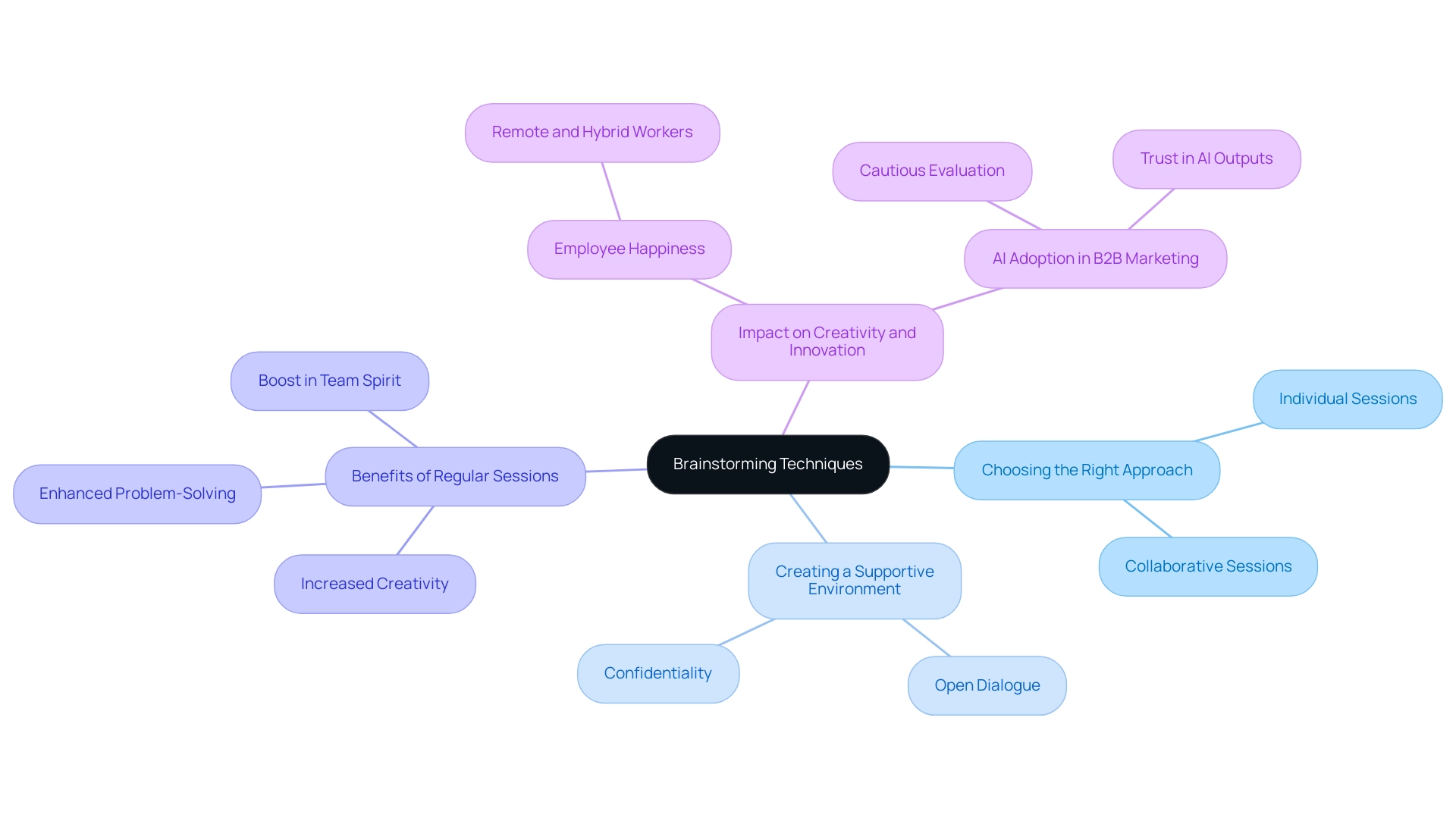
Conclusion
Embracing the art of brainstorming is vital for navigating the challenges of career transitions in today’s ever-changing job market. This creative process not only fosters collaboration and diverse perspectives but also empowers you to generate innovative solutions that can enhance your employability and financial stability. By leveraging classic techniques like freewriting and mind mapping, along with modern methods such as brainwriting and reverse brainstorming, you can unlock your creative potential and transform your ideas into actionable plans.
The significance of brainstorming goes beyond mere idea generation; it plays a crucial role in cultivating team cohesion and enhancing problem-solving capabilities. As organizations increasingly recognize the value of collaborative efforts, applying structured brainstorming techniques can lead to tangible improvements in productivity and innovation. Real-world examples illustrate how effective brainstorming sessions can drive business success and contribute to your personal agency, especially if you are looking to reinvent your professional path.
Ultimately, your journey toward career ownership and financial independence is supported by actively engaging in the brainstorming process. By creating a nurturing environment that encourages open dialogue and diverse contributions, you can harness the collective intelligence of your team to navigate challenges and seize opportunities. Now is the time to embrace brainstorming as a vital skill, ensuring that every idea contributes to a brighter and more empowered future in your career.
Frequently Asked Questions
What is brainstorming and why is it important?
Brainstorming is a dynamic and collaborative technique designed to generate a wealth of ideas in a condensed timeframe. It is important as it encourages free and creative thinking, allowing diverse perspectives to be explored, which is essential for innovation and problem-solving in various sectors, especially in a declining job market.
How does brainstorming benefit individuals navigating career changes?
Brainstorming fosters individual creativity and collaboration among team members, leading to richer outcomes. It can clarify ambitions and pinpoint actionable steps toward professional objectives, improving individuals’ sense of agency and control over their financial future during job transitions.
What role do AI ideation tools play in brainstorming?
AI ideation tools enhance innovation and creativity by supporting groups in producing ideas more effectively. They keep the idea generation process focused and productive, helping individuals in job transitions recognize potential job paths and opportunities relevant to their needs.
Can you provide examples of effective brainstorming techniques?
Effective brainstorming techniques include SCAMPER, where teams explore improvements through guided prompts, and the ‘Wishing’ method, where participants articulate ideal solutions and brainstorm pathways to achieve them. These methods help maintain momentum and structure during sessions.
How does individual concept generation impact group brainstorming?
Research indicates that generating concepts individually before collaborating in a group significantly enhances the originality and quality of concepts produced. This approach allows team members to offer unique viewpoints, enriching the overall brainstorming experience.
What traditional ideation methods can enhance creativity?
Traditional methods such as freewriting, mind mapping, and round-robin brainstorming are valuable for fostering creativity. Freewriting encourages a free flow of ideas, mind mapping organizes thoughts visually, and round-robin ensures inclusivity by allowing each participant to contribute.
How do brainstorming sessions impact business success?
Companies that emphasize brainstorming often report higher levels of creativity and collaboration, which are essential for maintaining a competitive edge. Statistics indicate that organized brainstorming sessions can lead to a 30% rise in originality of concepts, directly influencing business success.
Where can individuals find support for applying brainstorming techniques?
The Entrepreneur’s Source offers free coaching services to assist individuals in applying creative techniques during job transitions. Additionally, engaging with resources like ‘Your Career 2.0: A Survival Guide for The Battered Career Syndrome and Investor Syndrome’ can provide valuable guidance.


